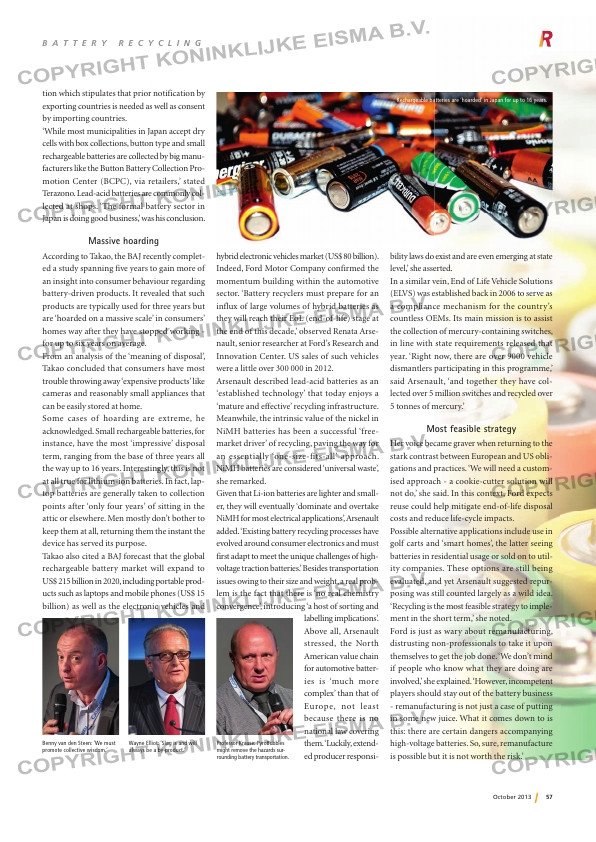Page 57 from: October 2013

57October 2013
B A T T E R Y R E C Y C L I N G
tion which stipulates that prior notification by
exporting countries is needed as well as consent
by importing countries.
‘While most municipalities in Japan accept dry
cells with box collections, button type and small
rechargeable batteries are collected by big manu-
facturers like the Button Battery Collection Pro-
motion Center (BCPC), via retailers,’ stated
Terazono. Lead-acid batteries are commonly col-
lected at shops. ‘The formal battery sector in
Japan is doing good business,’ was his conclusion.
Massive hoarding
According to Takao, the BAJ recently complet-
ed a study spanning five years to gain more of
an insight into consumer behaviour regarding
battery-driven products. It revealed that such
products are typically used for three years but
are ‘hoarded on a massive scale’ in consumers’
homes way after they have stopped working –
for up to six years on average.
From an analysis of the ‘meaning of disposal’,
Takao concluded that consumers have most
trouble throwing away ‘expensive products’ like
cameras and reasonably small appliances that
can be easily stored at home.
Some cases of hoarding are extreme, he
acknowledged. Small rechargeable batteries, for
instance, have the most ‘impressive’ disposal
term, ranging from the base of three years all
the way up to 16 years. Interestingly, this is not
at all true for lithium-ion batteries. In fact, lap-
top batteries are generally taken to collection
points after ‘only four years’ of sitting in the
attic or elsewhere. Men mostly don’t bother to
keep them at all, returning them the instant the
device has served its purpose.
Takao also cited a BAJ forecast that the global
rechargeable battery market will expand to
US$ 215 billion in 2020, including portable prod-
ucts such as laptops and mobile phones (US$ 15
billion) as well as the electronic vehicles and
hybrid electronic vehicles market (US$ 80 billion).
Indeed, Ford Motor Company confirmed the
momentum building within the automotive
sector. ‘Battery recyclers must prepare for an
influx of large volumes of hybrid batteries as
they will reach their EoL (end-of-life) stage at
the end of this decade,’ observed Renata Arse-
nault, senior researcher at Ford’s Research and
Innovation Center. US sales of such vehicles
were a little over 300 000 in 2012.
Arsenault described lead-acid batteries as an
‘established technology’ that today enjoys a
‘mature and effective’ recycling infrastructure.
Meanwhile, the intrinsic value of the nickel in
NiMH batteries has been a successful ‘free-
market driver’ of recycling, paving the way for
an essentially ‘one-size-fits-all’ approach.
NiMH batteries are considered ‘universal waste’,
she remarked.
Given that Li-ion batteries are lighter and small-
er, they will eventually ‘dominate and overtake
NiMH for most electrical applications’, Arsenault
added. ‘Existing battery recycling processes have
evolved around consumer electronics and must
first adapt to meet the unique challenges of high-
voltage traction batteries.’ Besides transportation
issues owing to their size and weight, a real prob-
lem is the fact that there is ‘no real chemistry
convergence’, introducing ‘a host of sorting and
labelling implications’.
Above all, Arsenault
stressed, the North
American value chain
for automotive batter-
ies is ‘much more
complex’ than that of
Europe, not least
because there is no
national law covering
them. ‘Luckily, extend-
ed producer responsi-
bility laws do exist and are even emerging at state
level,’ she asserted.
In a similar vein, End of Life Vehicle Solutions
(ELVS) was established back in 2006 to serve as
a compliance mechanism for the country’s
countless OEMs. Its main mission is to assist
the collection of mercury-containing switches,
in line with state requirements released that
year. ‘Right now, there are over 9000 vehicle
dismantlers participating in this programme,’
said Arsenault, ‘and together they have col-
lected over 5 million switches and recycled over
5 tonnes of mercury.’
Most feasible strategy
Her voice became graver when returning to the
stark contrast between European and US obli-
gations and practices. ‘We will need a custom-
ised approach – a cookie-cutter solution will
not do,’ she said. In this context, Ford expects
reuse could help mitigate end-of-life disposal
costs and reduce life-cycle impacts.
Possible alternative applications include use in
golf carts and ‘smart homes’, the latter seeing
batteries in residential usage or sold on to util-
ity companies. These options are still being
evaluated, and yet Arsenault suggested repur-
posing was still counted largely as a wild idea.
‘Recycling is the most feasible strategy to imple-
ment in the short term,’ she noted.
Ford is just as wary about remanufacturing,
distrusting non-professionals to take it upon
themselves to get the job done. ‘We don’t mind
if people who know what they are doing are
involved,’ she explained. ‘However, incompetent
players should stay out of the battery business
– remanufacturing is not just a case of putting
in some new juice. What it comes down to is
this: there are certain dangers accompanying
high-voltage batteries. So, sure, remanufacture
is possible but it is not worth the risk.’
Benny van den Steen: ‘We must
promote collective wisdom.’
Professor Krause: PyroBubbles
might remove the hazards sur-
rounding battery transportation.
Wayne Elliot: ‘Slag is and will
always be a by-product.’
Rechargeable batteries are ‘hoarded’ in Japan for up to 16 years.
p00_ICBR final..indd 57 03-10-13 15:28



